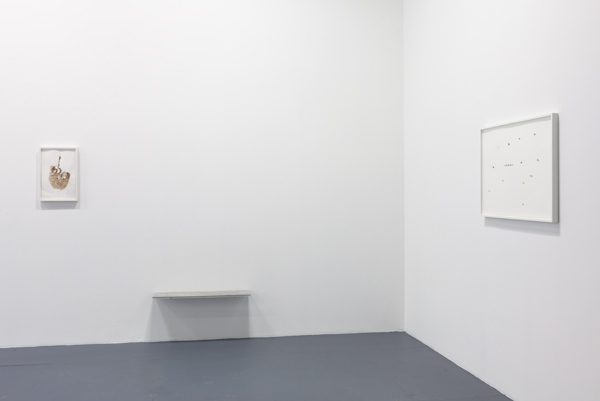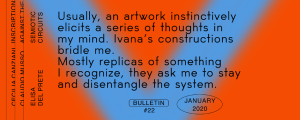Luke Stettner: this single monument at The Kitchen
Stettner’s “single monument” splinters into different forms though the exhibition, each work functioning as an autonomous homage to a history of modernism. this single monument (circles) (2014) is a an impact 3 x 4 series of framed slip drawings if circles on paper, each slightly different than the next, varying in density, tone and size. Some of the tracings are so faint as to not appear at all. The sequence ends abruptly with the eleventh drawing—there is no completion to the rectangular series, the visual narrative is left unfinished.
Ashbury’s understanding of an experience as a succession of moments is perhaps best interpreted in a series of framed letter-press documents—fragments of correspondence by American Modernist poet, William Carlos Williams. For This single monument, Stettner chose and re-printed excerpts of the letters that convey a realization of the writer’s mortality and hint at an understanding of their failure to achieve the status of greatness sought and expected in a modernist framework. The work is especially effective when see in light of William’s interest in the un-romantic, even the failures of American modernism, sentiments that reached an epoch in his 1946 epic Paterson—a work that foreshadows Robert Smithson’s treatment of the New Jersey town as remarkable in its identity as “the prototype of the American industrial community.”

Luke Stettner, this single monument (marble dust), 2014
Slip on paper
21 x 26 inches each
Courtesy of the artist and Kate Werble Gallery
This musing on the temporality and incompleteness of life reverberates across the gallery in this single monument (marble dust)(2014) –a small shelf on which the artist has lain the crushed marble remains of his father’s funerary urn (the actual ashes were displayed in The Grey Ash Soft (2011). By transforming the ashes of his father into the ground marble of the urn in which they were once stored, Stettner activates a type of non-site, questioning the values we associate with objects and the rituals associated with them. Stettner’s displacement of the actual ashes with those of the urn, a decorative object, reflects back the insecurities shared with Williams on the ability of art to interpret actual emotion and experience successfully into form.

Luke Stettner, this single monument (marble dust), 2014
Letterpress on paper
8 x 10.5 inches each
Courtesy of the artist and Kate Werble Gallery

Luke Stettner, this single monument (circles), 2014
Slip on paper
21 x 26 inches each
Courtesy of the artist and Kate Werble Gallery
Also working within a critical play of modernist sculpture, Stentter’s this single monument (paper roll) (2014) is on one level a Duchampian play—the readymade in this case an industrial size ream of paper, the type one might see at a professional printing facility. Where Stettner dematerialized the funerary urn into ashes, this single monument (paper roll) reverses the process—individual sheets of white paper are given sculptural form, becoming an imposing reminder of the history of minimalism with which artists like Stettner must grapple with as a canonized force and the physical sense of the blankness of the pages serving as a reminder of the creative work still to be done. Physically, this single monument (paper roll) is the only outwardly monument in the exhibition, its presence commands the space as an imposing and beautiful memorial, which, upon closer inspection, can unravel and de-stabilize at any moment.[3]

Luke Stettner, this single monument (marble dust), 2014
Slip on paper
21 x 26 inches each
Courtesy of the artist and Kate Werble Gallery
Throughout the exhibition, Stettner is able to combine a minimal romanticism with subtle reminders of the impossibility of these forms, of our continued failures, insecurities and pressures. The “monument” is clearly not singular at all, but a series of moments, references, slippages, reminders of history and our challenged relationship to it rather than a celebration of what was. The presence of so much blank paper, so much white space, creates a space for the exhibition as a whole to serve as a tender acceptance to the beauty to be found in failure, or even an monument to that.
Luke Stettner, this single monument, The Kitchen, New York
Through March 1, 2014
[1] Peter A. Stitt “John Ashbery: The Art of Poety no. 53” The Paris Review http://www.theparisreview.org/interviews/3014/the-art-of-poetry-no-33-john-ashbery (accessed February 26, 2014).
[2] These ideas have recently been articulated in philosophy by Timothy Morton, see Hyperobjects: Philosophy and Ecology after the End of the World (Minneapolis: The University of Minnesota Press, 2013).
[3] Stentter’s use of an alabaster and limestone based to support the roll and prevent it from unraveling are intentional referents to materials used in ancient Egyptian funerary monuments.
by Mary Coyne
in Focus on the American East
Mar 18, 2014























